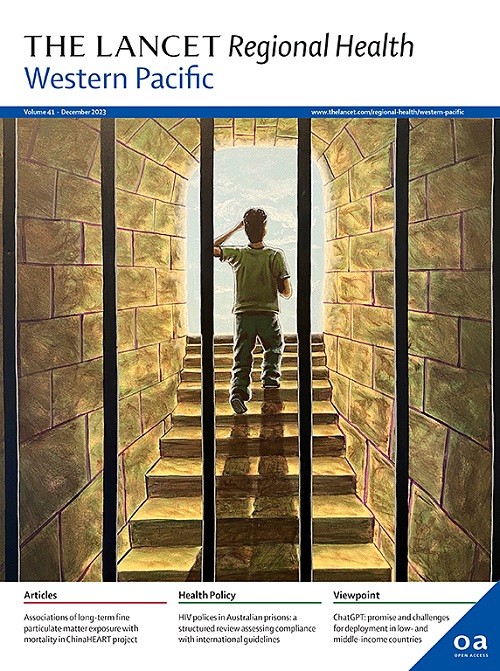Prevalence and temporal trends in myopia and high myopia children in China: a systematic review and meta-analysis with projections from 2020 to 2050
IF 7.6
1区 医学
Q1 HEALTH CARE SCIENCES & SERVICES
引用次数: 0
Abstract
Background
Myopia rates have risen in the past decades in China. New strategies for the prevention and control of myopia are now available, and understanding the prevalence and future trends in myopia and high myopia in children and adolescents in China may provide insights into the impact of implementing these measures. The study aims to provide updated data on the prevalence of myopia and high myopia in children and to project temporal trends in prevalence from 2020 to 2050 in China.
Methods
A systematic review and meta-analysis searching several databases in both English and Chinese: PubMed, Web of Science, Science Direct, China National Knowledge Infrastructure (CNKI), Wanfang, China Science and Technology Journal Database (CSTJ) with date limits from 01/01/2010 to 11/23/2024 was conducted. We included population-based or school-based studies in China that determined the myopia prevalence, based on the cycloplegic refraction, in children under 20. Studies with a response rate <70% or sample size <200 were excluded. A fixed-effect meta-analysis was used, and projections were made based on three scenarios: experience-based, maximum growth (maximum near-work, minimal outdoor time), and minimum growth (2 h outdoor time daily).
Findings
From 6555 reports, 82 studies with 218,794 participants were included. The overall myopia prevalence was 36.6% (95% CI: 36.4%, 36.8%), with rates of 2.6% in ages 0–4, 22.0% in ages 5–9, 45.4% in ages 10–14, and 67.2% in ages 15–19. High myopia prevalence was 5.3% overall, with rates of 0.1% in ages 0–4, 1.1% in ages 5–9, 3.0% in ages 10–14, and 9.5% in ages 15–19. Projections for 2030 under minimum growth, experience-based, and maximum growth scenarios were 26.8%, 46.2%, 56.0%; 2040 were 19.6%, 54.4%, 65.6%; and 2050 were 14.4%, 61.3%, 71.9%, respectively.
Interpretation
China is facing a substantial and potentially worsening epidemic of childhood myopia. This information will provide data for guiding implementation and evaluating the effectiveness of existing and new nationwide myopia prevention and control programs.
Funding
The Science and Technology Innovation Program of Hunan Province, China (2023RC1079, 2024RC5002).
中国儿童近视和高度近视患病率及时间趋势:2020 - 2050年预测的系统回顾和meta分析
在过去的几十年里,中国的近视率有所上升。预防和控制近视的新策略已经出现,了解中国儿童和青少年近视和高度近视的患病率和未来趋势可能有助于了解这些措施的实施效果。该研究旨在提供儿童近视和高度近视患病率的最新数据,并预测2020年至2050年中国儿童近视患病率的时间趋势。方法对PubMed、Web of Science、Science Direct、中国知网(CNKI)、万方、中国科技期刊库(CSTJ)等中英文数据库进行系统评价和meta分析,检索时间范围为2010年1月1日至2024年11月23日。我们纳入了中国基于人群或基于学校的研究,以确定20岁以下儿童的近视患病率,基于睫状体麻痹性屈光。排除应答率为70%或样本量为200的研究。使用固定效应荟萃分析,并根据三种情景进行预测:基于经验,最大增长(最大近工作时间,最小户外时间)和最小增长(每天2小时户外时间)。研究结果来自6555份报告,包括82项研究,218794名参与者。总体近视患病率为36.6% (95% CI: 36.4%, 36.8%),其中0-4岁为2.6%,5-9岁为22.0%,10-14岁为45.4%,15-19岁为67.2%。总体高度近视患病率为5.3%,其中0-4岁患病率为0.1%,5-9岁患病率为1.1%,10-14岁患病率为3.0%,15-19岁患病率为9.5%。2030年最低增长、基于经验和最大增长情景下的预测值分别为26.8%、46.2%和56.0%;2040年分别为19.6%、54.4%、65.6%;2050年分别为14.4%、61.3%、71.9%。中国正面临着儿童近视严重且有可能恶化的流行病。这些信息将为指导实施和评估现有和新的全国近视防治规划的有效性提供数据。湖南省科技创新计划项目(2023RC1079, 2024RC5002);
本文章由计算机程序翻译,如有差异,请以英文原文为准。
求助全文
约1分钟内获得全文
求助全文
来源期刊

The Lancet Regional Health: Western Pacific
Medicine-Pediatrics, Perinatology and Child Health
CiteScore
8.80
自引率
2.80%
发文量
305
审稿时长
11 weeks
期刊介绍:
The Lancet Regional Health – Western Pacific, a gold open access journal, is an integral part of The Lancet's global initiative advocating for healthcare quality and access worldwide. It aims to advance clinical practice and health policy in the Western Pacific region, contributing to enhanced health outcomes. The journal publishes high-quality original research shedding light on clinical practice and health policy in the region. It also includes reviews, commentaries, and opinion pieces covering diverse regional health topics, such as infectious diseases, non-communicable diseases, child and adolescent health, maternal and reproductive health, aging health, mental health, the health workforce and systems, and health policy.
 求助内容:
求助内容: 应助结果提醒方式:
应助结果提醒方式:


